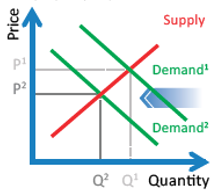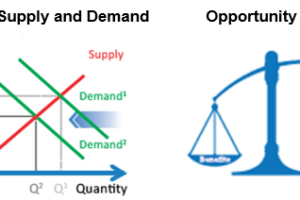
Money is lost every time you falsely assume demand will always be high and supply low for your product or service.
Worse yet, be in a declining industry due to product obsolescence, and you will own a struggling business. Remember 8-track tapes? What about cassette tapes and compact discs?
Learn the theory behind the Economic Law of Supply and Demand so that you can dial in your pricing and average daily cost to do business so you make, not lose, money.
Overview
The Law of Supply & Demand is a highly relevant economic theory that is often overlooked in understanding the power of price, value, and profits. In 1767, in The Wealth of Nations, Adam Smith identified how the unit price for a particular good varies until it settles at a point where the quantity demanded by consumers approximately equals the quantity supplied by producers at a particular price, which results in an economic equilibrium for price and quantity.
What makes knowing the theory of economic equilibrium a “so what” for business is the fact that no marketplace ever achieves economic equilibrium. Yes, it’s a terrific academic point to teach, but it’s irrelevant in making more money with less stress. What is relevant is knowing the recognized drivers of supply as a determiner of price and demand as a price influencer.
The four recognized drivers of supply as a determiner of price involve the following:
- The production costs: how much does the item cost to produce
- The technology used in production and its rate of advancement
- Your knowledge of and expectations about future prices
- The number of suppliers that exist in the current market
The four recognized drivers of demand as an influencer of price are:
- The income levels of those buying
- The prices of related goods and services
- The consumers’ expectations about future prices and incomes
- The number of potential customers
Understanding which demand and supply scenario your business competes in will help you better understand what pricing your business circumstances will allow you to charge:
- If supply increases while demand remains unchanged, a market surplus results in lower pricing.
- If demand increases while supply is unchanged results in a market shortage that will drive up higher pricing.
- If supply decreases while demand is unchanged, you will have a market shortage, leading to higher pricing.
- If demand decreases while supply is unchanged, you will get a market surplus, resulting in lowering pricing.
For example, if supply is tight for your particular product and demand is high for similar products, you can earn higher profits. Unfortunately, you’ll also face the risk of new competitors entering the attractive market. Even more unfortunate is how rare it is to compete in this type of market.
When supply is high, and demand is low, you will find yourself engaged in a price battle. Most businesses operate in this type of market, where the winners are often those with the lowest production costs.
The price you charge for your products and services significantly impacts both the demand for what you do and the amount of profits you are likely to earn on each sale. You better position your business model to make you more money through the application of the principle of opportunity costs, the law of supply and demand, and the 7-P Framework to what you do. Using the knowledge you derive through these insights is how you better ensure you have a profitable business model.
